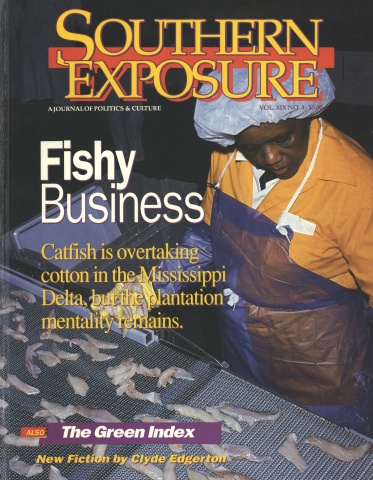Stock Car Racing

This article originally appeared in Southern Exposure Vol. 19 No. 3, "Fishy Business." Find more from that issue here.
Dirty, glamorous, wonderful, and ugly, stock car racing is one Southern institution that still honors its humble beginnings, even in its glitzier modem forms. Although tracks now stretch from California to Maine, stock car racing remains firmly rooted in good-ole boy traditions of hard liquor and fast cars.
The earliest stock car racers were Depression-era “likker runners” who souped up their cars to transport bootleg whiskey to market. Farmers who operated illegal stills enlisted the young daredevils to outrun local sheriffs and federal tax agents along the backroads of Appalachia and the Deep South. Legends soon grew up around drivers like Junior Johnson and Curtis Turner, and it was only a matter of time before they started racing each other.
Early races were often disorganized local events staged at old horse tracks by shady promoters who sometimes ran off with the gate receipts. One 1936 race in Daytona Beach was run on a track literally carved out of the sand. In 1947 race promoters Bill Tuthill and Bill France organized the National Association for Stock Car Auto Racing, hoping to make the sport more respectable —and more profitable.
NASCAR got its big break two years later when it staged the first race of “new cars” directly off the showroom floor. The event was a huge success, launching an expensive rivalry between car manufacturers that continues to this day.
Modern stock car racing has far outpaced its modest origins to rank as one of the largest spectator sports in the country. Last year more than 3.3 million people attended Winston Cup and Busch Grand National races. Southern stock car fans accounted for two-thirds of the total attendance, with North Carolina, Florida, and Virginia ranking as the biggest racing states nationwide.
The popularity of stock car racing has attracted big money to the sport, making it difficult for local racers to keep up. Cars can easily run at least $50,000. The constant wear and tear makes them expensive to maintain, and well-heeled sponsors are hard to come by. For most small-time drivers, racing is a family affair, with relatives and friends contributing all the time and money they can spare. Local drivers have good reason to want to break into the big time. Richard Petty, the “winningest racer of all time,” has earned over $7 million in his career. In many Southern states, Petty and other big-name drivers like A.J. Foyt and Carl Yarborough receive adulation generally reserved for sports icons like Michael Jordan.
But at local tracks across the region, racers must content themselves with less recognition and low pay. On a typical summer weekend at the Orange County Speedway in Rougemont, North Carolina, eager racers in their teens compete with veterans in their thirties and forties. Chicken wire surrounds the grandstands to prevent overzealous fans from throwing objects on the track in the hopes of causing a wreck. The largest purse for any of the races is $2,400 — barely enough to earn a living. Terry Dease, age 25, has been racing at the speedway since he was 19. “My father used to race,” Dease says. “You race for the thrill of it. On the track, you can get speeds of 100 or 110 miles per hour.”
Maurice Hill, a veteran of 30 years and the defending champion of the Orange County Speedway, echoes Dease’s youthful enthusiasm. “I started out as a crew member and worked my way up,” says Hill. “I’ve been at this since 1960. I like it because it’s competitive.” Asked if his wife Joan worries much, Hill puts an arm around her and grins. “She’s used to it.” Joan smiles and looks down at the ground. She doesn’t look so sure.
Tags
Heidi Fisher
Heidi Fisher is an editorial assistant with the Institute for Southern Studies (1991)